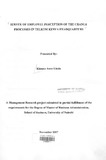| dc.description.abstract | The objectives of this study were to determine the employees' perception of the change
processes in Telkom Kenya and to establish factors that influence their perception.
The research design appropriate for this study was that of a survey of employee
perception of the change process in Telkom Kenya. The principal advantage of a survey
is that it can collect a great deal of data about an individual respondent at one time. The
population consisted of all Telkom employees. The sampling frame was employees both
in management and support. The data analysis method is quantitative. Data presentation
is in the forrn of tables.
If change efforts are to be effective, people need to change the ways in which they
interact with other areas of the organization. People will have to really understand their
new roles and responsibilities and will have to focus on the horizontal linkages between
processes and functions. A new mindset is required. However, it is important to recognize
that it is not just about streamlining operations and ensuring better information and
communication. There is a danger that if the organization focuses on this as the object of
streamlining processes and implementing new systems efficiency, it will create a narrow
focus. This may eliminate the in depth understanding of strategic imperatives, income
generation and service delivery issues and practical operating realities. While many
organizations are at least adequately prepared to facilitate organizational transitions, few
organizations really provide enough focus on how to address personal transitions or the
need to ensure that personal transitions are aligned with organizational transitions.
Firms that undertake change in their organization often aim to improve their performance
in terms of, for example, higher profits, better responsiveness to the market, and longterm
competitive advantage. The real value of organizational change rests on its ability to
alter an organization's identity, strategy, structure, operation or human resources as a
means to enhance firm performance. | en |

